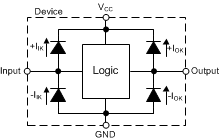SCAS962B November 2023 – September 2024 SN74AC8541
PRODUCTION DATA
- 1
- 1 Features
- 2 Applications
- 3 Description
- 4 Pin Configuration and Functions
- 5 Specifications
- 6 Detailed Description
- 7 Application and Implementation
- 8 Device and Documentation Support
- 9 Revision History
- 10Mechanical, Packaging, and Orderable Information
Package Options
Refer to the PDF data sheet for device specific package drawings
Mechanical Data (Package|Pins)
- RKS|20
- DGS|20
- PW|20
Thermal pad, mechanical data (Package|Pins)
- RKS|20
Orderable Information
6.4.3 Clamp Diode Structure
As shown in Figure 6-2, the inputs and outputs to this device have both positive and negative clamping diodes.
CAUTION:
Voltages beyond the values specified in the Absolute Maximum Ratings table can cause damage to the device. The input and output voltage ratings may be exceeded if the input and output clamp-current ratings are observed.
 Figure 6-2 Electrical
Placement of Clamping Diodes for Each Input and
Output
Figure 6-2 Electrical
Placement of Clamping Diodes for Each Input and
Output